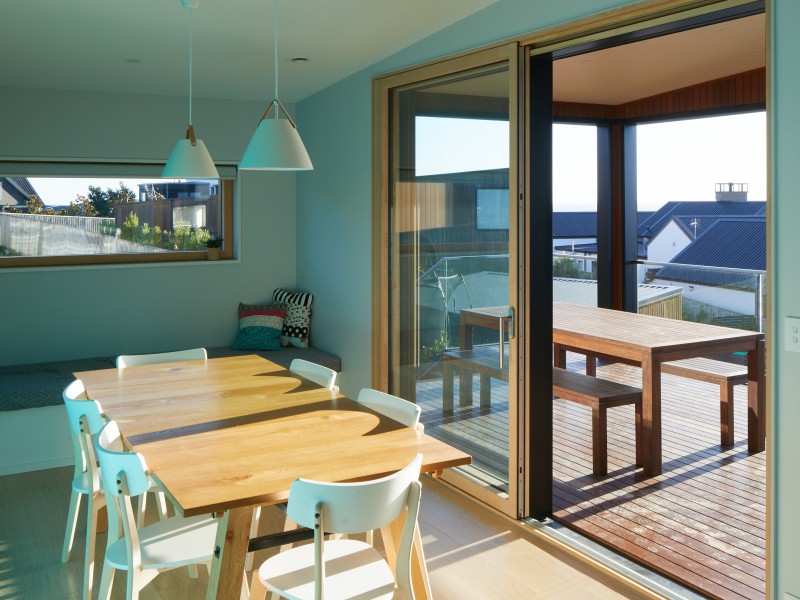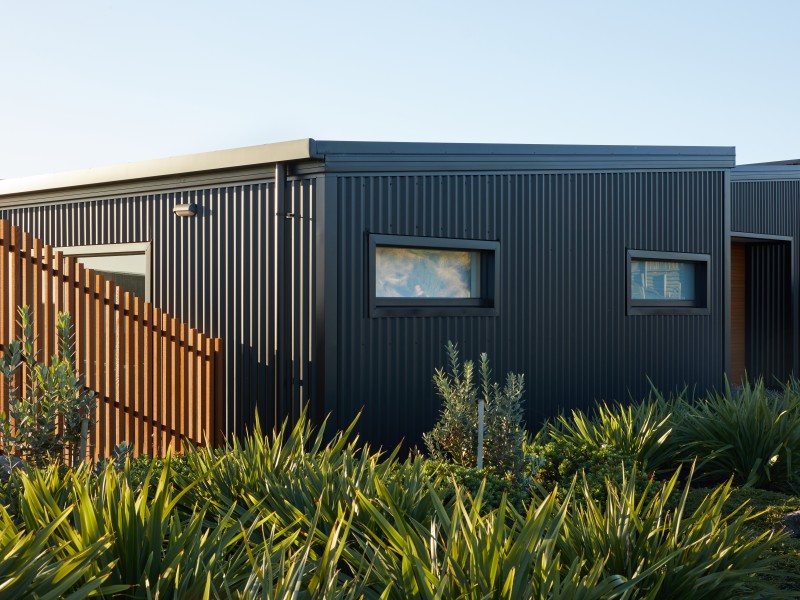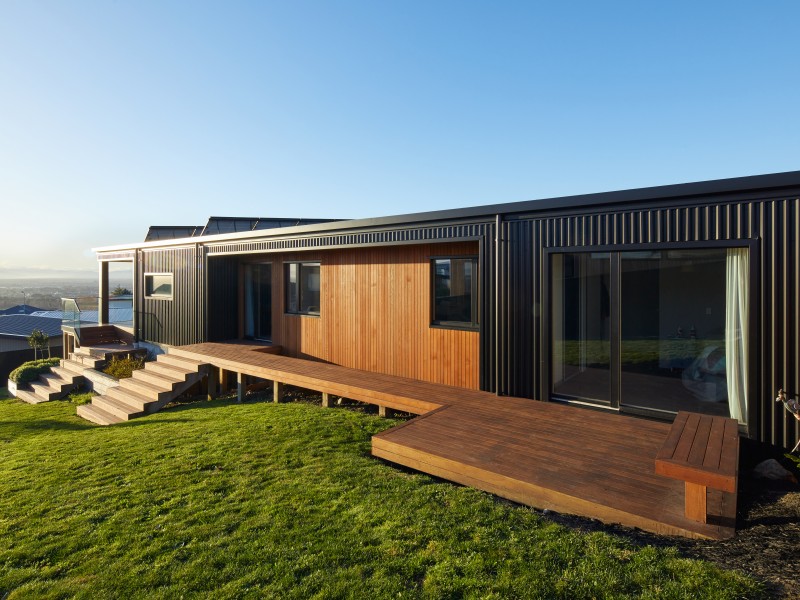When Mark and Elizabeth Browne bought a section in the hills above Christchurch their number one aspiration was creating a comfortable and healthy home for their young family.
Now their striking, highly sustainable, holistic house has been awarded a brilliant 9 Homestar rating.
Essentials
Owner: Mark and Elizabeth Browne
What: single-storey domestic dwelling; 260m2; four bedrooms, two bathrooms
Where : suburb of Westmorland
Location: lower slopes of the Port Hills with views of Christchurch, the Canterbury Plains and the Southern Alps Ka Tiritiri-o-te-Moana
Occupancy: two adults and three children
Project certification: 8 Homestar design rating (2020) 9 Homestar built rating (December 2022)
Project Snapshot
Architect: Karen Manson, Meta Architects
Main contractor: CRAFT
SIP installer: Chatterton Builders
Homestar assessor: Amanda Crosby, Meta Architects
Project timeline: purchased section 2016; concept and design phase complete 2018; construction commenced mid-2019; occupancy August 2020

Achieving a high level of performance was centre stage in Mark and Elizabeth Browne’s conversation when they embarked on building a new family home.
Now that dialogue has translated into a 9 Homestar rated dwelling tucked into the contours of a sloping site above Christchurch.
With its external wall and ceilings constructed from SIP panels (high-performing thermally efficient composite panels), the house comprises solar power, an earthquake resilient design, an airtight envelope, and glass fronted northwest-facing living spaces that open into a functional outdoor room under the main roof to prevent overheating.
It is a house that speaks clearly about the benefits of green design and construction.
“We’re delighted to achieve a 9 Homestar rating as a measure of the performance of our home. We’re really pleased with the warmth in winter for low energy input. Equally in the summer months we can achieve a comfortable internal temperature with minimal cooling activity,” says Elizabeth.
- water use is measured via a new Christchurch City Council online monitoring programme Water Reporter. The household aims to stay below its 700 litre/day limit
- energy generation and usage is measured and monitored through a solar power phone app
- a Wi-Fi heat pump app provides the temperature in the living room at any time of the day
“The MHRV system is really effective for keeping our house dry and easier to keep warm. We don’t feel the need to open windows to prevent stuffiness. In winter it’s a joy to walk into the house and feel the warm atmosphere. We tend to walk around in T shirts with no need to have heat pumps constantly inputting energy into the house - our monthly winter power bill maxes out around $160. And the internal atmosphere is really quiet and peaceful due to the thick walls, roof and double glazed windows,” Mark says.
When Mark and Elizabeth bought their section they were already knowledgeable about the benefits of a green building.
As a structural engineer and project director, Mark contributes to sustainable and Green Star rated designs. During a two year stint with an engineering company in Canada he worked with experienced LEED engineers.
Their decision to build a high performance home was also shaped by their experience of living in a warm, centrally heated apartment in Vancouver and an energy-guzzling 1960s dwelling in Christchurch where “we sweated in summer and froze in winter.”
“We knew that a well-insulated house wasn’t a luxury but essential.”
The couple saw Homestar as a mechanism to validate the performance of their new home and the design choices they had made along the way.
“A Homestar rating is an external performance measure of what we set out to do. It isn’t just us saying “our house is awesome”. Homestar provides the objective assessment to see how well it stacks up against other high performance houses.”
Homestar also meant they could take advantage of their bank’s advantageous healthy home lending package.
Mark says bringing on board an architect who specialises in high performance houses was paramount to the project.
And that architect, Karen Manson from Meta Architects, says the close alignment of values between herself and her clients is reflected in the design of the house and its 9 Homestar rating.
“We are very proud of the result and to have this project audited by the NZGBC confirms to us that our skills are recognised by experts in the sustainable building field.”
“It’s so important that we continue to raise the bar for sustainable homes until Homestar becomes incorporated into mandatory building standards.”
Karen says design inspiration for the house was widespread.
“The simplicity of the single pitched roofline is derived from rural and coastal New Zealand architecture and even though the suburb is only recently developed and consists of new buildings we have enjoyed drawing from Christchurch’s rich architectural heritage particularly its mid-century homes.”

Karen says the most exciting green features of the house include:
- window and shading designed to control solar gain for heating and cooling
- airtightness (.83 air changes per hour)
- low ongoing operational costs - the result of 10 rooftop solar panels producing just over 5,000 kWh per year of clean energy (an average home uses 7,000 kWh per year)
- ducted ventilation and heat recovery system providing healthy, warm air constantly
- construction methods - using a combination of prefabrication and on-site building to achieve the best outcome
“One of my favourite spaces in the house is the outdoor room adjacent to the dining room. It’s a great space to enjoy the site and views and also does double duty as it cuts out the hot afternoon sun on summer days to prevent the house from becoming too hot.”
Homestar assessor, Amanda Crosby from Meta Architects, says the house displays a conscious effort to meet the sustainable goals articulated by Homestar.
“While it achieves high points across the energy, health and comfort categories, a high performing home alone is not enough to automatically get a top score. The native plant landscaping, solar panels, material selections, water use and even appliances were all careful choices contributing to the 9 star rating. ”
“Homestar has added big picture objectives that elevated this project from a high performance house to a home that is responsible, innovative and mindful of its wider impact.”
She says the degree of innovation has been impressive.
“It is not about bells and whistles - there are ways to improve the sustainability of a house without actually increasing material costs. Here we have a house with a low damage design (LDD) which ensures it will not only safely withstand earthquakes but will only suffer damage to parts that are economical to repair. After seeing the colossal amount of materials going to landfill post the Christchurch earthquakes this stands out as a very considered approach to sustainability.”
Amanda says the amalgamation of its green features offer an effortless, comfortable and healthy place to call home.
“Mark and Lizzie will have negligible power bills and ongoing maintenance costs. And the children will never know what it is like to grow up wiping condensation off windows!”
“The wonderful thing about a Homestar rating is that the positive impacts of the house extend to the neighbourhood and local environment too. Because its sustainable features were all considered from the outset - the result is a beautifully understated home that actually improves its surroundings.”
Ben Fearnley, director and builder of CRAFT Specialist Builders, says collaboration and team work has been the key to the project’s success story.
“It’s been a collaborative effort between us building the house, Meta Architects and the homeowners working hard to achieve the final steps to gain this result.”
He says knowledge gained during the project has been valuable and has resulted in further work for CRAFT in the sustainable building space.
Ben’s suggestion for anyone planning to build a high performance house is to do your homework.
“Work out what’s important to you and what you want to achieve long term. Approach an architect who has a portfolio of work of a similar nature as their experience will be invaluable.”
Meanwhile Brent Chatterton, SIP fabricator and installer at Chatterton Builders, says the industry needs to get on board with best practice.
“I think more builders need to embrace information about sustainability and Homestar to build above code minimum and raise the standard of our homes in New Zealand. We shouldn’t leave it up to the building regulators to lift that bar.”
Homeowners Mark and Elizabeth believe if you are considering a high performance or Homestar rated house you should be brave and aim high.
“You don’t have to settle for a stock standard home. It does take more effort, research and commitment to build a high performance house but the extra capital investment will pay dividends in the long run.”
“We have a comfortable and healthy environment for our family. That’s priceless and makes the less travelled path of a high performance home so worthwhile.”
Photography by Sarah Rowlands.
